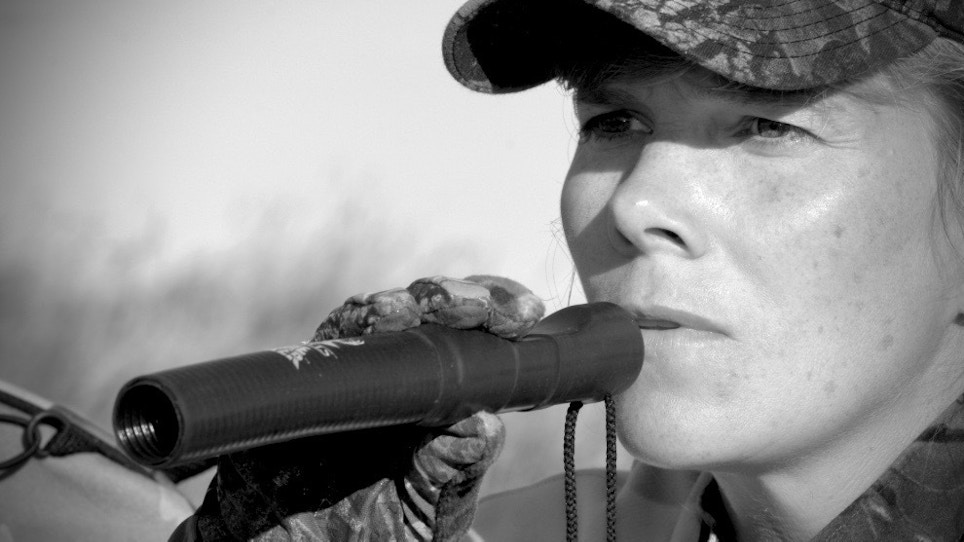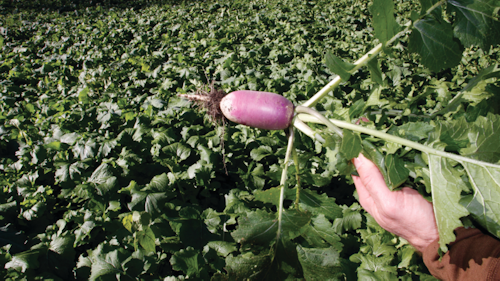Out of the millions of hours of filmed hunts broadcast on networks and the internet, one segment stands out most in my mind. It’s the sight of a giant, non-typical whitetail passing by the stand of a well-known TV personality. When the walking buck slipped into a shooting lane, the hunter, likely on autopilot, blatted out a dreadful imitation of a deer bleat that sounded more like the screaming agony from a disturbed ewe.
The distressing sound definitely met its goal as the buck skidded to a halt from the high-rise audio alarm. The next event was foreseeable. At the launch of the arrow, the buck “jumped the string,” ducking lower than a world champion limbo dancer. Take a lesson from that example. When you want a buck to stop, you need to do it in a manner that fits the situation.
With a muzzleloader, shotgun or centerfire rifle, the blat would have been acceptable. Deer cannot “jump the bullet.” However with a bow or crossbow, the bleat was a poor choice. Not only was the sound unnatural, it was too loud and the deer was too close. In this case, the sound the hunter used to stop the buck was alerting, not questioning.
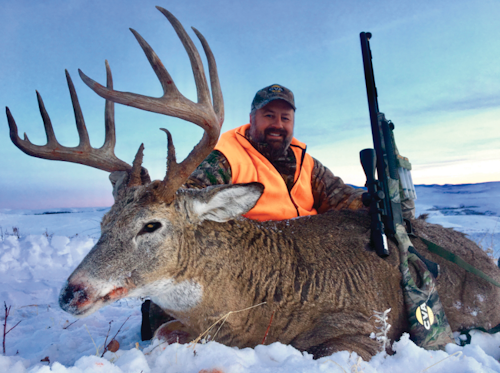
Chad Schearer knows a thing or two about making good shots. In addition to hosting the Shoot Straight TV series with his wife Marsha and sons Walker and Wyatt, Schearer is the director of advertising and media relations for CVA muzzleloaders. Plus, he’s been a Montana outfitter and guide for 25 years. He’s always on the hunt, manipulating whitetails into perfect positions for him to make great shots.
“Stopping a buck for an accurate shot is the best thing to increase your odds to make the most effective kill possible,” Schearer says. “You do it for the respect of the animal and, by making a great shot, you don’t waste any great-tasting venison. That’s a win-win.”
Food Plots and Scents to Stop a Buck
You cannot deny the stopping ability of a good food plot. Even when pursing does, most bucks have to stop and nibble. That works in fields, but what about in woodlands? A recent trend in property management includes planting interior roads and trails into mini plots. It’s ideal for short-stopping those late-arriving bucks. To stop bucks during season,plant hardy crops in shooting lanes that receive a daily dose of sunshine . Clover, turnips and chicory work well, especially where the sun filters in to energize the mini plots.
Farming for whitetails takes a big bankroll. If your uncle doesn’t have majority ownership in John Deere, then there other options. Make a stop at your local sporting goods outlet. Whitetail scents of all flavors have the ability to arouse curiosity and force a deer to stop and sniff the roses — at least those covered in urine.
You can dispense scents via a temperature-controlled dripper (that only activates during the warmer daylight hours) over a real or mock scrape. You can dip a wick in scent and place it upwind of a shooting lane. My favorite method is to carry a spray bottle of a product like Wildlife Research Center’s Special Golden Estrus and mist vegetation along a trail in a shooting lane. You need to aim for an area that is nose level to a deer, and don’t overdo it. Too much can create confusion, leading to panic. A few blasts are all you need to make a deer stop for a perceived, non-threatening investigation.
In all cases where you need to place a scent or refill a dispenser, scent control is a must. Any human scent left in a shooting lane or near a scrape has the ability to not only alarm a deer, but also to change the behavior of a mature buck. Wear rubber-bottomed boots, use scent elimination products and avoid touching nearby vegetation to ensure curiosity doesn’t cascade into chaos.
“I guided on some river bottoms where deer come to alfalfa every night, but not always where we wanted them to,” Schearer says. “One of the tactics we discovered to make them take the right trail and even stop for standing shots, was to block a trail that was heavily used, but didn’t offer a wind advantage for us. They’d come to that intersection and either give us a standing shot or reroute giving us an even better shooting opportunity.”
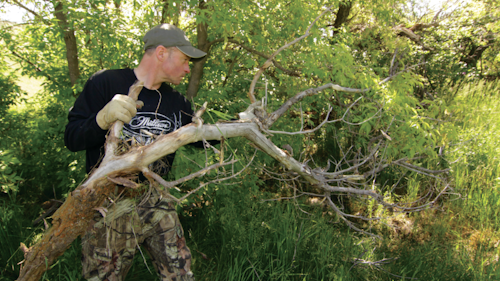
Decoys to Stop a Buck
Sometimes a bit of shock can help you get the shot off, but don’t bet on the over-augmented blat of a deer to do the trick. Adversarial can work well when bucks are in pre-rut or the throes of the breeding frenzy.
A ruse that works particularly well for bowhunters is the use of a decoy. Not only does it stop a buck to investigate, when placed properly, it turns a buck’s attention away from you. This allows a hunter to draw his bow or even pick up his muzzleloader as the buck’s attention is clearly focused away. There is the slight chance a buck may not stop to appraise the opponent, but most bucks pause before engaging. Thus, giving a hunter vital seconds to take a standing shot.
“I’ve used decoys a lot while rattling and grunting, even in pre-rut situations to get a curious look,” Schearer says. “Not only can it stop a buck for a shot, but it can also bring a deer 20 to 30 yards closer. Bucks are always checking the social and pecking order of an area, so seeing another deer makes them stop and take notice.”
Calls to Stop a Buck
During firearm season, decoys aren't recommended. Instead, consider using deer vocalizations, or calls. For firearm hunters, any call with a dominant tone has the ability for shock and awe and will stop a buck in its tracks. Bowhunters need to be a bit more selective in their choice.
The grunt call is the easiest call with stopping power to master. Test the waters with a soft grunt first, and use it sparingly. You want the soft grunt to make a buck question if it even heard it, thus prompting a pause. A buck’s footsteps in crunching leaves or the rustling of limbs could overpower your call and that’s when a second “urp” at a higher level may be required. Test cautiously until you hit a note that sparks braking action. Follow a similar test pattern with the bleat call. You should also practice both calls using only your mouth for a speedy, hands-free approach.
“You always want to start with a non-threatening vocalization to stop a deer,” Schearer says. “I usually start with a doe bleat. Begin softly and then you can increase the volume if a deer doesn’t hear it, but this natural sound urges a deer to stop out of curiosity. I’ll bleat at least three to four times and make sure my muzzleloader is up to take advantage of the pause.”
To reach out a bit further, possibly to stop a buck in a shooting lane farther away or to overpower gusty winds covering your grunts, consider the snort wheeze. The snort-wheeze is most often heard during the rut, with dominant bucks relying on it to send a threatening, adversarial message. It’s guaranteed to make any buck stop and look, so be sure you’re ready to shoot. On quiet days when a buck is close, you should avoid it while bowhunting. Sure, a buck will stop, but odds are they’ll duck with the twang of a bowstring.
A final adversarial ploy you can improvise is placing a rub when and where you want it. Research shows most bucks like to rub on the most aromatic species of tree available. Plant a cedar fence post upwind along a trail and it’s as addictive to a buck as a video game joystick is to a junior high student. They just have to engage, giving you the green light for a shot, near or far.
How to Scare a Deer Into Stopping
NOTE: The following scary maneuvers are not meant for bowhunting.
Begin with a whistle. A shrill whistle could make a buck pause with the curiosity to look for an angry bird. For gun hunters, it’s a near certainty that — if the buck stops — your shot will have ample time to connect.
My favorite, and one I use nearly every hunting season, is the coyote bark. Coyotes inhabit every corner of whitetail country, so the sound isn’t out of the ordinary. But it does force a deer to stop and look for the danger. Again, barking too close ignites panic and movement an arrow can rarely overcome. But bark at most deer, 100 yards or beyond, and it’s a guaranteed showstopper.
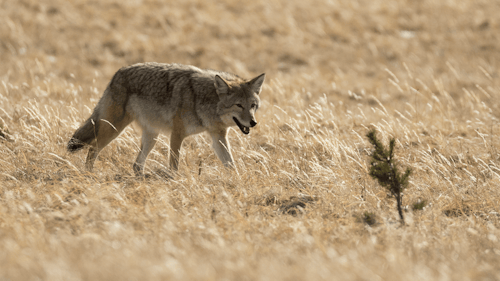
“If a non-threatening approach like deer vocalizations doesn’t work, I pull out the stops and will holler something like, 'hey,'” Schearer says. “It’s a desperation move, and you need to realize it could mean never seeing a dominant buck again. But typically the doe will stop in a chasing situation and that will stop the buck. You need to be ready to drop the hammer the second he hits the brakes.”
BONUS: Overcoming Whitetails' Superior Sense of Smell
Whether you’re trying to erase traces of your footsteps or ensure you don’t leave traces of human scent on woodland objects you've touched, scent elimination plays a critical role in your success.
To make it easy, carry a scent-eliminating spray bottle in your pack like Scent Killer Gold. Spray the stuff on your hunting clothes, and it'll last for more than a day. Be sure to let it dry, though. You can also use it to erase human scent while constructing mock scrapes or setting decoys.
Moreover, even though you may have washed with an anti-odor body wash, sometimes the hike in or even a stand adjustment can cause you to break a sweat. That’s where a packet of field wipes can quickly come to the rescue. Use them to touch up perspiration on your brow or neck, and if nothing else, they come in handy if nature calls.
